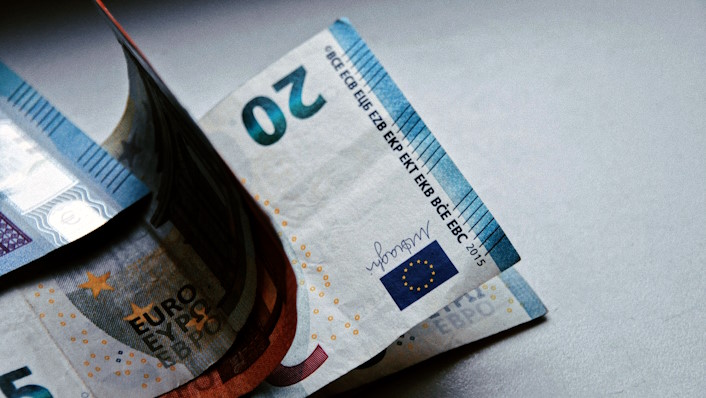Money Market Funds in Europe: Everything You Need to Know
They beat savings accounts in interest, but wrapping your head around them may take take a bit.

A money market fund is an investment fund – typically an exchange-traded fund (ETF) or mutual fund – that pools the money of multiple investors to purchase short-term debts like European government and corporate bonds. The goal of money market funds is to generate income from the interest and coupons received from investing in these types of loans and then pass those payouts on to investors. When interest rates are high, loans are more expensive, and money market funds generate attractive yields, but when rates fall, their returns fall too.
Between 2008 and 2023, investing in cash didn’t earn you much because interest rates were near zero.1 Now, with rates having come back up, borrowing is more expensive, and this has once again made money market funds worth considering as part of a well-balanced portfolio. These funds are ideal if you want to protect your money against inflation’s bite without diving into high risks. They’re also easy to sell if you want to shift your investment to other assets.
Investors from Europe typically invest in Euro-based money market funds. These funds produce returns that match or even beat the Euro Short-Term Rate, which is better than most bank savings accounts. If you’re a European investor, you can access these funds through an online brokerage, bank, or other financial financial institution. Trading them is no different than buying or selling shares in any other type of investment fund.
What you need to know
European money market funds yield returns that surpass those of typical savings accounts, but most European investors haven’t heard of them. Here’s what you need to know.
- A Euro-based money market fund is a mutual fund or ETF that primarily invests in short-term debt issued by European governments, supranational entities, banks, and corporations.
- You can buy and sell shares of a money market fund through a brokerage or bank just like any other type of publicly traded mutual fund or ETF.
- Yields of European money market funds mirror the Euro Short-Term Rate due to their investment in short-term Euro-denominated debt.
- Money market funds produce better income than regular savings accounts, but they come with a bit more homework when it comes to getting the hang of how they work.
- Money market funds are typically used as a place to park excess cash temporarily during a high-interest rate environment; they’re not considered suitable as long-term investments.
- USD money market funds are available to European investors, and the higher interest rates can be tempting, but they come with high currency risk.
- Though not covered by deposit insurance like bank accounts, money market funds are regarded as among the most low-risk investments.
What is a money market fund?
A money market fund is a type of investment fund that can be in the form of an ETF or a mutual fund. It invests in a basket of low-risk debt instruments like government bonds, corporate bonds, supranational bonds, treasuries, and certificates of deposit.2 This means that when you invest in a money market fund, you’re indirectly lending your money to governments, banks, and big corporations. In return, these borrowers pay interest to the fund, which it in turn passes on to you and other investors.
When choosing which debts to invest in, European money market funds usually aim for a diversified collection of assets whose combined yields are in line with the Euro Short-Term Rate. This rate reflects the overnight borrowing costs between financial institutions in the euro area. In line with the short-term rate, depending on whether the fund you invest in is of the distributing or accumulating type, you’ll either get periodic dividends or those earnings will be reinvested to increase your investment’s value.
How much do money market funds pay?
Euro-based money market funds usually aim to match the interest of the Euro short term rate (€STR). This means you can expect yields that are similar to this rate.
Like short-term bond funds, money market funds deal in short-term debts. However, unlike bond funds, money market funds registered in the EU must follow a set of specific rules called the Money Market Funds Regulation. These rules require them to invest primarily in ultra-short debt with brief maturities and restrict them from investing beyond a certain percentage in instruments issued by the same entity. For example, they must have 7.5% or 10% of their money in instruments that can be turned into cash in 1 day and 15% or 30% in 1 week. Furthermore, they can invest only up to 5% in one issuer’s instruments and only up to 10% in deposits with one bank.3
Money market funds and the Euro Short-Term Rate (€STR)
Euro-based money market funds usually aim to reflect the interest rates of a deposit earning interest according to the Euro Short-Term Rate, abbreviated as €STR or ESTER. The €STR is calculated by the European Central Bank (ECB) based on the interest rate at which financial institutions in the Eurozone lend money to each overnight.4 Since banks operate on a fractional reserve system, they often need to borrow money from each other daily to ensure they have enough funds on hand to meet short-term obligations and reserve requirements.
Interestingly, the ECB doesn’t directly set the €STR. It’s a value based on past real-world interbank transactions. At the same time, the ECB’s monetary policy on broader interest rates greatly influences it: When the ECB raises interest rates, it becomes more expensive for banks to borrow money, and this pushes up the €STR. Conversely, when the ECB lowers interest rates, it becomes cheaper, which sends the €STR down.
This mechanism has a cascading effect on the money market. It particularly affects the interest rates for loans that are repaid quickly, like the ones banks give to each other overnight or bonds that are paid back within six months. Since short-term loans in Euros best reflect what the current borrowing situation is like in the Eurozone right now, money market funds invest in them. They do so to get a clear and current view of how much it costs to borrow money right now.
Best money market funds in Europe
The accumulating version of the Xtrackers ETF is the largest and has been running the longest among funds available to private investors in Europe. The Lyxor fund offers the lowest TER. Both funds also have distributing versions available.
How much interest do European money markets funds pay?
Euro-based money market funds generally aim to yield interest rates in line with the Euro short-term rate (€STR), though some try actively to outperform the benchmark. You can find the current €STR on the website of the ECB.
It’s worth noting that the interest rates of these money market funds might not always be on par with the current €STR. This is because money market funds continually purchase new debt while waiting for older debts to mature. If previously acquired debt holdings have interest rates that differ from current market offerings, there’s going to be a slight discrepancy between the fund’s actual yields and the €STR. When the ECB adjusts interest rates, the changes don’t manifest instantly. It typically takes some time for money market funds to catch up with these new rates, given their ongoing transactions and previously held debts.
How European money market funds work
A money market fund, when discussed within the European context, is an open-end investment fund. Open-end means the fund is a type of collective investment that can both issue new shares and buy back existing ones at any moment. Most publicly traded mutual funds and ETFs use the open-end structure. These funds pool money from multiple investors to buy specific assets, predominantly short-term bonds in the case of money market funds.
When investors invest in these funds, the fund manager buys more of the underlying assets and issues more shares, meaning the fund’s size can always expand to accommodate more capital.
European money market funds follow an EU rulebook known as the UCITS Directive. UCITS, short for “Undertakings for Collective Investment in Transferable Securities,” requires investment funds to operate in a certain way, enforces regulatory standards, and allows the cross-border sale of securities across European member states. For retail investors, the key benefit is that a UCITS fund incorporated in one EU country is allowed to be sold and bought in every other member state. Due to certain tax and legal advantages, most of the largest UCITS funds are incorporated in Ireland or Luxembourg.
In practical terms, a European money market fund works more or less like any other type of mutual fund or ETF:
- To be listed, the managing entity of the fund must adhere to specific operational and regulatory criteria. These include maintaining requisite minimum capital, producing documentation like a prospectus and KIID, and securing approval from the relevant financial regulatory authority. Moreover, the fund must explain its strategy to track a designated index. Collaborative agreements with stock exchanges, securities depositories, and clearing systems are also necessary.
- Upon listing, the fund usually initiates with a few million euros in initial assets under management. As more investors buy shares of the fund, it issues new shares and simultaneously acquires more of the designated debt proportionally with the targeted index and the cost parameters expected by its investors.
One real-world example of a money market fund is the Xtrackers II EUR Overnight Rate Swap UCITS ETF. Established in 2007, this retail-accessible money market fund follows the Deutsche Bank Euro Overnight Rate Total Return Index. The index’s primary objective is to mirror the performance of a deposit that accrues interest based on the Euro short-term rate (€STR). The fund, domiciled in Luxembourg, is enlisted on five distinct European exchanges and can be accessed throughout the EU, including Switzerland and the UK. Its investment portfolio comprises short and long-term bonds issued by EU member nations, the European Union, the World Bank, and both the US and UK.
How to invest in European money market funds
Buying shares of money market funds is similar to buying other ETFs or mutual funds: you can do it through your online brokerage or bank. The main hurdle for many people isn’t buying the shares but picking the right fund and actually gaining access to it through their investment account. Here’s a guide to help you out:
- Check the tax situation where you live. Before you invest in money market funds, make sure it makes sense tax-wise.
- Some countries tax dividend distributions from money market funds, and funds in general, more heavily than interest from a regular savings account. Also factor in that these funds don’t come with deposit insurance.
- Many countries tax ETFs and local mutual funds differently. Sometimes, even if a money market mutual fund has a higher management fee, it might be better than a low-cost ETF when taxes are taken into account.
- Money market funds typically come in two variants: a distributing and an accumulating version. Pick the one that makes more sense in your situation.
- Review the funds. You’ll generally want a fund that manages at least a few hundred million euros and has low fees—ideally 0.10% or below. When you’re checking out different funds, pay attention to:
- Where the fund is registered (its domicile). Ireland and Luxembourg are common fund domiciles, but their tax treatment of dividend distributions or sales might vary depending on the tax treaty they hold with your country.
- How long it’s been around.
- How much money it manages.
- Management fees.
- Replication method. If the fund uses a swap-based strategy or actually holds the assets it’s tracking.
- Find the fund through your brokerage. Not all brokerages offer money market funds, especially the smaller or discount ones. If yours doesn’t, you might need to think about opening a new account with one of the larger players.
Advantages and disadvantages of money market funds
Money market funds offer a good middle ground for people who want better yields than a regular bank savings account but don’t want to take on the higher interest rate risk of bond funds. When interest rates are up during inflationary times, money market funds will provide good payouts that help preserve capital. While investing in them is not as straightforward as transferring funds to a savings account, the potential rewards can make it worthwhile.
Advantages of money market funds
For investors who are planning on saving money they need in the next few years, and who prefer to keep risks low, money market funds offer some compelling benefits over traditional cash-saving methods.
1. Higher returns than savings accounts
Money market funds almost always have higher yields than savings accounts, usually a few percentages. These funds invest in short-term debts, like government or corporate bonds, which generally yield more than standard bank interest.
They’re also fast to adjust to market changes as they continuously buy new bonds. This means that if interest rates go up, yields from money market funds are quick to follow, while savings accounts might lag or not adjust at all.
2. No lock-in periods
Unlike some bank savings accounts, which often require you to lock your money away for months or even years, you can buy or sell money market funds whenever stock exchanges are open.
Easy and quick access to your funds can come in handy during an emergency situation, but it’s also a convenience if you need to make an unexpected withdrawal.
3. Very low-risk
European money market funds usually receive a “1” rating in the risk-reward profile required for UCITS funds. They’re not insured like bank savings but are still considered low-risk because they invest in short-term debts from trusted issuers. This includes bonds and treasuries from large financial institutions and developed countries with high credit ratings.
Holding debt with short-term maturities means money market funds are less sensitive to interest rate changes: when interests rise, they’re fast to stock up on newly issued better-paying bonds because they don’t have to wait very long for their current bonds to mature.
Furthermore, focusing on Euro-denominated bonds minimises currency risk for investors who primarily deal in euros or euro-linked currencies. For example, if your primary currency is the Euro, and you invest in bonds that are also in euros, exchange rate fluctuations won’t be a concern. This is a problem you will face if you decide to invest in US Treasuries or UK Gilts since those are in dollars and pounds.
4. Tax-efficient, sometimes
Depending on your country’s tax rules, money market funds may be treated more favourably tax-wise compared to bank interest. If your country taxes dividends or capital gains from mutual funds or ETFs at lower rates than bank interest income or bond coupon payments, money market funds may be the most tax-efficient choice. On the other hand, if those get better tax rates, they might be a smarter option for you.
5. Capital preservation
When interest rates go up, it’s usually because of higher inflation. Money market funds serve as a shield during such times. Typically, they won’t beat inflation, but they do cushion its impact. Historically, stocks have been a much better long-term investment, but for money you’ll likely need in the next few years or when interest rates are climbing, money market funds are a much safer play.
Disadvantages of money market funds
Money market funds are ideal for parking cash short-term, but they’re not suitable for long-term aims like retirement. They don’t provide capital growth, and over longer periods, their returns have historically been lower than stocks. While the pros are many, money market funds have drawbacks, too. Among them:
1. No deposit insurance
Unlike a bank deposit, investments in money market funds aren’t protected. They’re not covered by any deposit insurance scheme. If your bank collapses, your deposit will be reimbursed up to a certain amount, usually €100,000. Money market funds don’t offer this safeguard as they are investments, not deposits.
2. Low real returns
Money market funds are typically not the best choice for long-term investment goals, such as retirement planning, because they don’t provide any real growth over the long run. When taking into account inflation and taxes, the actual returns from money markets are very often less attractive than at first sight.
For example, an investment of €100,000 in a money market yielding 4.20% would seem to generate €4,200 annually. However, assuming a 4.7% inflation and a hypothetical 25% tax on the profits, the gain could actually be a loss of €1,550 in terms of purchasing power. Of course, the same amount invested in riskier assets, or kept as cash, could have produced a larger loss.
3. Bond risks
A jump in interest might seem appealing at first sight because money market funds earn you more income. But, when rates go up, it gets expensive for everyone – governments, businesses, and individuals – to borrow money, and this usually isn’t a good thing for the economy as a whole. When rates go up, governments spend larger portions of their budget to pay bondholders, which means they might cut back on important services and productive investments.
Countries faced with high debt levels and interest repayments are often forced to make tough choices like cutting spending or raising taxes. If the debt keeps piling up without growth to offset it, there’s a risk of entering a debt crisis, which can plunge nations into a detrimental cycle of borrowing and high debt-to-GDP ratios.
Printing money is sometimes viewed as a solution for countries with control over their currency. For instance, the U.S. can print dollars, the EU can print euros, and the U.K. can print pounds to manage their national debt. However, an influx of printed money can trigger high levels of inflation, which dramatically reduces a currency’s value, causes prices to soar, and makes investors more hesitant to buy the country’s bonds. Cutting back on spending or increasing taxes are usually more sustainable solutions, although often not well-received by the public.
Sources
- European Central Bank. “Key ECB interest rates.” https://www.ecb.europa.eu/stats/policy_and_exchange_rates/key_ecb_interest_rates/html/index.en.html
- EFAMA. “Money Market Funds.” https://www.efama.org/policy/eu-fund-regulation/money-market-funds
- EUR-Lex. “Regulation (EU) 2017/1131 on money market funds.” https://eur-lex.europa.eu/legal-content/EN/LSU/?uri=CELEX:32017R1131
- European Central Bank. “Overview of the euro short-term rate (€STR).” https://www.ecb.europa.eu/stats/financial_markets_and_interest_rates/euro_short-term_rate/html/eurostr_overview.en.html



